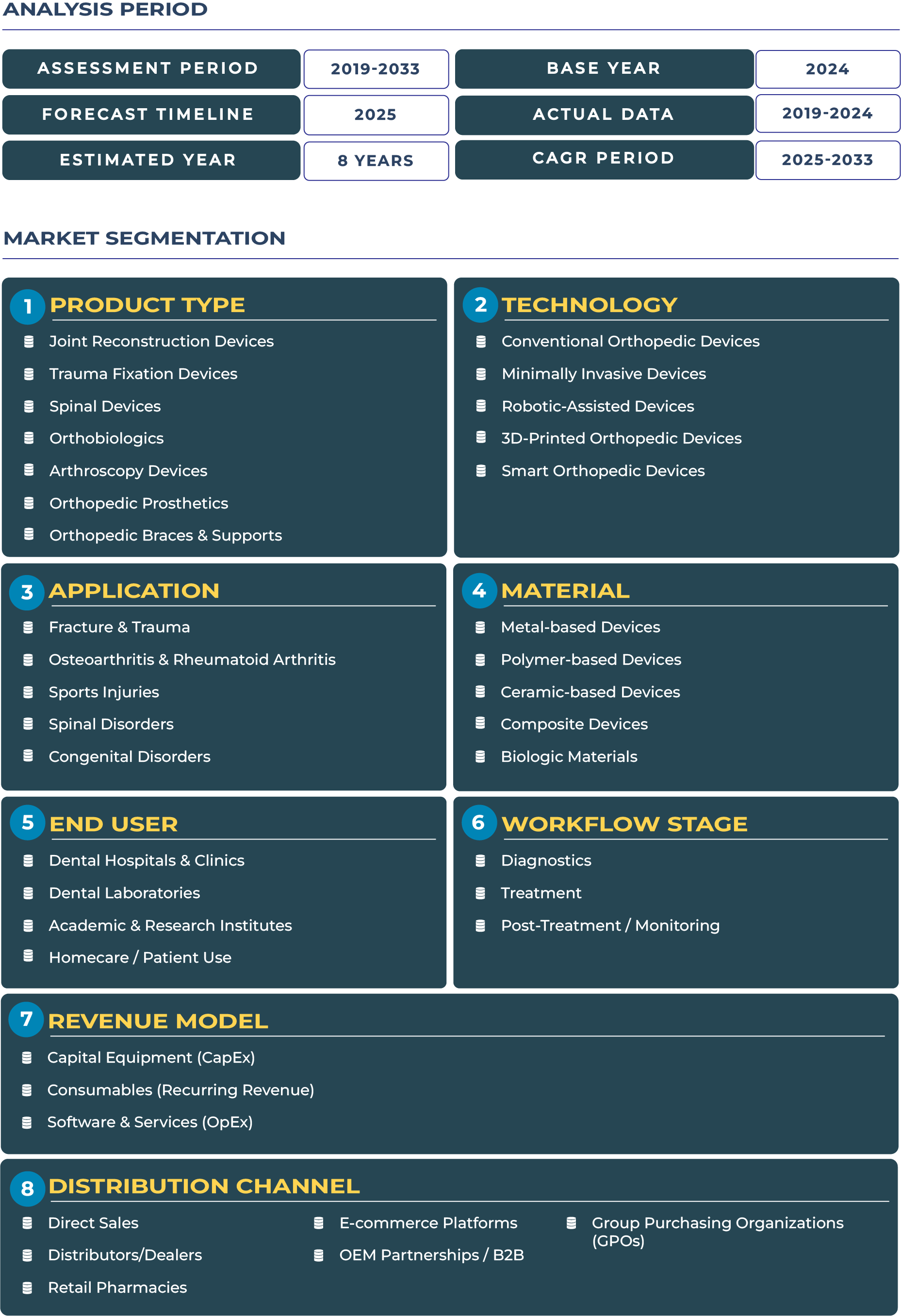France Orthopedic Devices Market Outlook: Patient-Centric Reforms Drive a Transformational Growth Curve
The France orthopedic devices market is poised for sustained growth, reflecting a well-coordinated blend of public investment, private healthcare expansion, and medical innovation. As of 2025, the market is valued at USD 2.37 billion, with projections estimating it will reach USD 3.37 billion by 2033, expanding at a CAGR of 4.5% (2025–2033). This progression is supported by France’s strategic focus on healthcare reforms, which include modernization of public hospitals, expansion of ambulatory surgery centers, and introduction of streamlined device trials under the Haute Autorité de Santé (HAS). At a time when political and economic pressures across Europe remain high, France orthopedic devices sector demonstrates resilience. By combining patient-centered policies with structured health technology assessments, France has created an environment where orthopedic devices—from advanced spinal implants to orthobiologics—are both medically validated and financially accessible. The result is a market that is not only expanding but also redefining the European benchmark for regulatory and patient-centered growth.
France Orthopedic Devices Market: Patient-Centric Reforms Redefining Growth and Innovation
France has long been recognized as a leader in patient-focused healthcare reforms, and this focus is significantly shaping the country orthopedic devices industry. Unlike many other European nations, France has pursued systemic modernization of its healthcare infrastructure, emphasizing patient safety, structured reimbursement, and local clinical validation of medical technologies. This approach has created a fertile ground for adoption of advanced orthopedic devices, particularly as the country balances aging demographics with a robust state-supported healthcare system. Orthopedic prosthetics, joint reconstruction implants, and trauma fixation solutions are seeing increasing traction in both public and private sectors, driven by reforms that ensure broader patient access while promoting innovation in medical device evaluation.
Growth Catalysts: Structural Healthcare Investments Unlock Market Expansion
One of the key drivers of the French orthopedic devices landscape is the government’s significant investment in public hospital modernization. France’s healthcare system, which relies heavily on its extensive network of public hospitals, has been supported by multi-billion-dollar funding programs designed to upgrade surgical facilities and adopt cutting-edge medical technologies. These modernization funds are directly benefiting orthopedic procedure volumes, particularly in trauma and joint replacement surgeries. Additionally, the strong national HTA framework ensures that devices undergo rigorous evaluation, which in turn fosters confidence among surgeons and patients. Parallelly, the growing private ambulatory sector is accelerating demand for orthopedic devices designed for minimally invasive procedures. Clinics in Paris, Lyon, and Marseille have emerged as hubs for rapid adoption of arthroscopy devices and spinal solutions, reflecting the dual strength of both public and private demand drivers within France orthopedic devices industry.
Challenges in the French Orthopedic Devices Ecosystem: Regulatory Rigor and Financial Constraints
Despite its promising growth trajectory, the France orthopedic devices sector faces structural restraints that manufacturers must navigate carefully. The strict pricing and reimbursement processes governed by national and regional agencies create lengthy approval timelines, often delaying market access for innovative devices. Budgetary constraints in public hospitals have also intensified procurement pressure, leading to competitive tendering processes that prioritize cost-efficiency over premium innovation. Furthermore, regional variability in device approvals introduces complexity for suppliers targeting multiple Laender-like jurisdictions within France. This unevenness can slow down nationwide adoption, particularly for premium orthopedic prosthetics and biologic implants. Together, these factors highlight that while France offers a sizable market, it demands a high level of adaptability, compliance, and strategic alignment from orthopedic device manufacturers.
Emerging Trends and Untapped Opportunities in France orthopedic devices Sector
The France orthopedic devices market is undergoing a notable transformation through trends such as ambulatory migration, where procedures traditionally performed in hospitals are shifting toward outpatient clinics. This transition aligns with the government’s emphasis on efficiency, cost reduction, and improved patient experience. Another emerging trend is the growing focus on orthobiologics, which are increasingly integrated into sports medicine and regenerative treatments across France. Additionally, the influence of value assessment models from HTA is shaping procurement decisions, favoring devices backed by robust clinical evidence. Opportunities also abound, particularly in ambulatory-ready implant kits designed to optimize outpatient workflows and partnerships with private hospital groups that are investing heavily in surgical infrastructure. Regional distributor alliances are further opening access for international players to enter secondary cities such as Bordeaux and Toulouse, reinforcing the market’s multi-tier growth structure.
Competitive Landscape: Strategies Redefining Market Positioning
The competitive landscape of France orthopedic devices industry is marked by both global giants and domestic leaders. Companies such as Stryker continue to expand their footprint through advanced spinal and arthroscopy solutions, while local manufacturers benefit from proximity to France’s HTA-driven evaluation processes. Strategic moves include building HTA-compliant evidence packages that smooth reimbursement pathways, targeting private ambulatory clinics with turnkey orthopedic offerings, and sponsoring regional outcomes studies that reinforce clinical credibility. For instance, collaborations between device manufacturers and teaching hospitals in Paris are strengthening adoption of premium joint reconstruction implants. These strategies reflect a sector where clinical validation, regional alignment, and private-public partnerships define competitive advantage, making France an attractive yet highly regulated market for orthopedic device companies.







